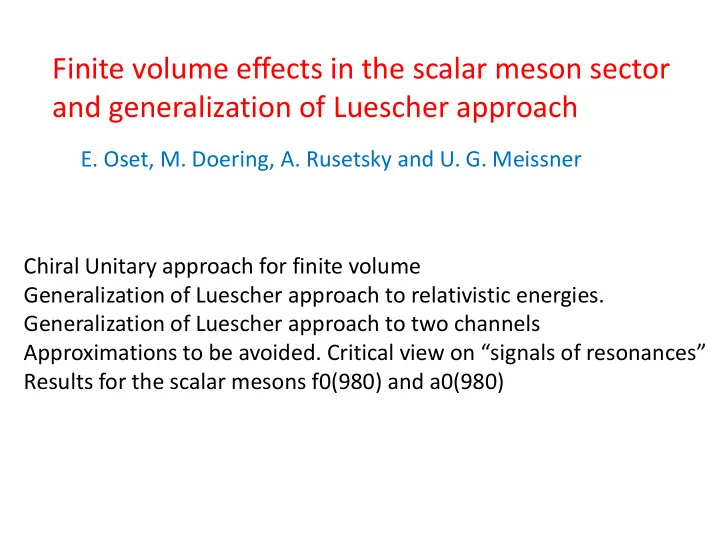

Finite volume effects in the scalar meson sector and generalization of Luescher approach E. Oset, M. Doering, A. Rusetsky and U. G. Meissner Chiral Unitary approach for finite volume Generalization of Luescher approach to relativistic energies. Generalization of Luescher approach to two channels Approximations to be avoided. Critical view on “ signals of resonances ” Results for the scalar mesons f0(980) and a0(980)
We simulate the QCD lattice results using the chiral unitary approach in the scalar meson sector Next we study the system in a finite box of dimension L 3 , demanding periodic boundary conditions Then we look for poles of T in the finite volume: If we had only one channel For one channel and the energies E, eigenenergies of the box In the continuum: END OF FORMALISM IN ONE CHANNEL This difference is cut off independent
π π channel We fix a certain value of L Determine E via the equation
Connection to Luescher approach In Luescher approach one obtains: As a side effect of our approach, we can evaluate the Z function making our G functions non relativistic (practical and efficient method), but they are not needed in our approach.
Determination of the eigenenergies in the box with two channels
Analysis of two channel results with finite volume using our approach with just the ππ channel = Relativistic Luescher approach Luescher one channel analysis Exact result: the rise of δ indicates the appearance of the f 0 (980) Luescher one channel analysis Exact result The one channel gives a rise of δ , as if there was a resonance, even when it has disappeared. WARNING for Lattice
Relativistic approximation done in Bernard, Lage, Rusetsky, Meissner JHEP (2011). Keep only first term to be able to use Luescher function. Approximation fails below threshold. Better avoid it in coupled channels. We use exact result now.
Strategy to get phase shifts in two channel analysis: Take three trajectories (E versus L) and determine three L’s for the same energy These equations determine the 3 V’s for each E. With them we use the Bethe Salpeter equations with a cut off for G the same as the one chosen for , the results are cut off independent
Three methods used: 1) Use three different trajectories using standard boundary conditions 2) Use asymmetric boxes, L x , L y , L z different 3) Use twisted boundary conditions The three methods work
Twisted θ = Π Twisted θ = Π /2 Periodic boundary condition
These results are not tautology: the initial chiral unitary approach required a certain cut off . The results obtained from our analysis are cut off independent
Analysis of errors: Red: twisted boundary conditions Green: asymmetric boxes Brown: three different levels
Different strategy: aproximate method, model dependent. Assume, as it occurs with chiral potentials at lowest order, that Take about 15 eigenenergies of the box with errors of 10 MeV Make a fit to the data to determine the 6 parameters, a ij , b ij To determine errors of induced phase shift, choose random a ij , b ij such that Xisq= Xisq min +1
Periodical boundary conditions Mixture of periodical and twisted b. c. Method works, but if original potential has a different s dependence than the linear one assumed in the analysis, the erros become larger
Conclusions Even if the levels are obtained in two channels, the one channel ππ analysis works well till close to the K Kbar threshold: BUT RELATIVISTIC FORMALISM IS NECESSARY The raise of δ close to the K Kbar threshold in one channel IS NOT indicative of the coming f 0 resonance, but a threshold effect BEWARE OF SUCH SIGNALS IN QCD LATTICE RESULTS We provide an exact relativistic treatment, which generalizes Luescher nonrelatistic approach. No need of the ordinary Luescher function Z The formalism is far simpler than the standard Luescher approach. An extension is done to two channels with relativistic kinematics We prove that the method works and it is possible to obtain resonances that couple to two channels (most of them) from future lattice results.
Recommend
More recommend